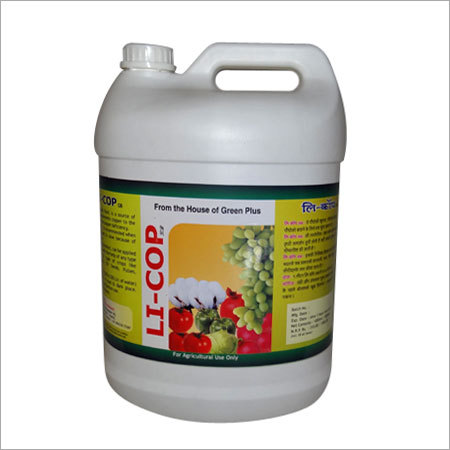
LI-COP Biopesticide. Biopesticides are cheap and do not leave any harmful residue in the soil, water or the air, eliminates by killing only the targeted pests or microorganisms.
For long farmers and farm produce consumers alike have been shying away from chemicals that are used to fight pest and diseases that also harm crops and animals. As farmers are already aware, overuse of these chemicals for pest and disease control is to blame for the destruction of beneficial insects that control pests naturally with little harm to the environment.
The use of Integrated Pest Management (IPM) strategies to control pests and diseases has been found to be the most effective way to combat pest and best practice in disease management. This is due to the many benefits to overcome in the use of synthetic pesticides.
By use of biopesticides and fungicides that protect humans, animals and the environment farmers have a lot to enjoy. Unlike chemicals, biopesticides and fungicides which are cheap and do not leave any harmful residue in the soil, water or the air, eliminates by killing only the targeted pests or microorganisms.
Biopesticides are made from organic material and are therefore free of any synthetic substances (chemical substances). Biopesticides can be either from plant origin or made from microbes. All types of biopesticides kill one or several specific targets.
Biopesticides are friendly to non-target organisms, they are specific. Other chemical pesticides used at high dosage of high toxicity will end up killing the pest and all other living organisms in the ecosystem (environment). However, biopesticides are very specific and will only kill the targeted pest but cause no harm to the useful natural enemies, humans, animals and the environment.
They are cheaper. Biopesticides are made from naturally occurring products which makes its production cost cheaper. This translates into lower prices of the finished product as compared to synthetic pesticides.
They are safe - Biopesticides are not only environmentally-friendly but also safe for human and animals. More people are becoming health-conscious and prefer organically produced products.
Real IPM Products. The products come in various sizes or even sachets, making it convenient and cost-friendly even to small-scale farmers.
Diseases management. There are a wide range of products available in the market from various commercial companies. These range from different types of bio-pesticides to traps and coating (such as fungicides used for seed dressing).
Examples of Bio-pesticides include Real Bacillus subtilis (bio-fungicide): This is produced from a soilborne bacterium. It is a very effective product against powdery mildew and can be applied as a foliar spray. It is available in form of a fermented product and its recommended application rate is 1-2L/ha (½ litre - 1 litre per acre).
Real Trichoderma (bio-nematicide and bio-fungicide): It is made from a fungus found in the soil known as Trichoderma asperellum. This fungus can grow on plant roots. Its application mode can be in form of root application or foliar spray. It has several benefits including; increasing the ability of plants to compete with soil-borne diseases that affect roots by enhancing growth and branching of roots, destruction of root nematode eggs, protecting the plants from being attacked by Meloidogyne spp as well as promotion of resistance in plant.
The product is used for management of root knot nematodes and phytophthora. Its application can be done by drenching at a rate of 200ml/ha (100ml per acre) if one uses the spores in vegetable oil formulation and 1kg/ha (½kg per acre) when using the granular form.
Pest Management can be done through the following methods; Metarhizium anisopliae. Real IPM (Kenya) has been working in collaboration with the International Centre of Insect Physiology and Ecology (ICIPE) and has come up with products made from metarhizium including Metarhizium 69, Metarhizium 78 and Metarhizium 62.
Metarhizium is a naturally – occurring entomo-pathogenic fungi (a fungi that woks like a parasite) ending up killing the pest). Being a contact bio-pesticide, the efficacy of the product is affected by the amount of water used. When too much water is used, run-off water from the plant canopy reduces its effectiveness. Metarhizium spores germinate and colonize the pest, killing it in 2 to 4 days.
Metarhizium is compatible with various fungicides and insecticides. Additionally, it is not harmful to natural enemies; beneficial parasitoids and predators which is very important in their conservation. They also have formulations for management of fruit flies.
Real Metarhizium anisopliae 69. It is formulated as pure fungal spores in vegetable oil. It is commonly used in the management of whiteflies, mealy bugs, snout beetles and thrips. When soil application is made, the surface of the soil below the crop should be covered. It is used at a rate of 200ml/ha (80ml per acre).
Real Metarhizium anisopliae 62. It is meant for management of aphids. However, for the control of waxy aphids, a wetting agent should be added to the product to enhance adhesion of the product to the pests’ body. Its application rate is 200ml/ha.
Achieve (Metarhizium 78). It is used in the management of spider mites (Tetranychus urticae and T. evansii) and varroa mite, a parasite of bees. It can be combined with use of Phytoseiulus and Amblyseius andersoni in management of red spider mites. It is applied at a rate of 1Litre/ha (½litre per acre).
















Comments powered by CComment